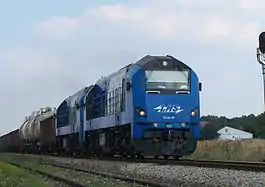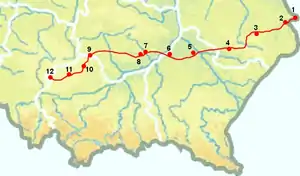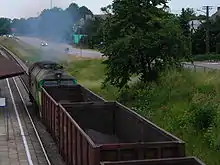Linia Hutnicza Szerokotorowa
Broad Gauge Metallurgy Line (Polish: Linia Hutnicza Szerokotorowa, LHS), is the longest broad gauge railway line in Poland. Except for this line and a few very short stretches near border crossings, Poland uses standard gauge. The single-track line runs for almost 400 km from the Polish-Ukrainian border crossing just east of Hrubieszów to Sławków Południowy (near Katowice). It is used only for freight, mainly iron ore and coal. It is the westernmost part of the broad-gauge network based on the former Soviet Union.
| Broad Gauge Metallurgy Line | |||
|---|---|---|---|
 ST40s on the Broad Gauge Metallurgy Line. | |||
| Overview | |||
| Owner | PKP LHS Sp. z o.o. | ||
| Locale | Southern Poland | ||
| Termini | Bug River Bridge (Poland-Ukraine border) Sławków | ||
| Stations | 6 | ||
| Service | |||
| Type | Freight | ||
| System | S64/R65 (main) UIC60 | ||
| Services | 1 | ||
| Operator(s) | PKP LHS Sp. z o.o. | ||
| History | |||
| Opened | Construction commenced November 15, 1976, opened November 30, 1979 | ||
| Technical | |||
| Line length | 394.65 km (245.22 mi) | ||
| Track length | 600 km (372.82 mi) | ||
| Track gauge | 1,520 mm (4 ft 11 27⁄32 in) Russian gauge | ||
| Electrification | No | ||
| Operating speed | 80 km/h (50 mph) | ||
| |||
Linia Hutnicza Szerokotorowa | |||||||||||||||||||||||||||||||||||||||||||||||||||||||||||||||||||||||||||||||||||||||||||||||||||||||||||||||||||||||||||||||||||||||||||||||||||||||||||||||||||||||||||||||||||||||||||||||||||||||||||||||||||||||||||||||||||||||||||||||||||||||||||||||||||||||||||||||||||||||||||||||||||||||||||||||||||||||||||||||||||||||||||||||||||||||||||||||||||||||||||||||||||||||||||||||||||||||||||||||||||||||||||||||||||||||||||||||||
|---|---|---|---|---|---|---|---|---|---|---|---|---|---|---|---|---|---|---|---|---|---|---|---|---|---|---|---|---|---|---|---|---|---|---|---|---|---|---|---|---|---|---|---|---|---|---|---|---|---|---|---|---|---|---|---|---|---|---|---|---|---|---|---|---|---|---|---|---|---|---|---|---|---|---|---|---|---|---|---|---|---|---|---|---|---|---|---|---|---|---|---|---|---|---|---|---|---|---|---|---|---|---|---|---|---|---|---|---|---|---|---|---|---|---|---|---|---|---|---|---|---|---|---|---|---|---|---|---|---|---|---|---|---|---|---|---|---|---|---|---|---|---|---|---|---|---|---|---|---|---|---|---|---|---|---|---|---|---|---|---|---|---|---|---|---|---|---|---|---|---|---|---|---|---|---|---|---|---|---|---|---|---|---|---|---|---|---|---|---|---|---|---|---|---|---|---|---|---|---|---|---|---|---|---|---|---|---|---|---|---|---|---|---|---|---|---|---|---|---|---|---|---|---|---|---|---|---|---|---|---|---|---|---|---|---|---|---|---|---|---|---|---|---|---|---|---|---|---|---|---|---|---|---|---|---|---|---|---|---|---|---|---|---|---|---|---|---|---|---|---|---|---|---|---|---|---|---|---|---|---|---|---|---|---|---|---|---|---|---|---|---|---|---|---|---|---|---|---|---|---|---|---|---|---|---|---|---|---|---|---|---|---|---|---|---|---|---|---|---|---|---|---|---|---|---|---|---|---|---|---|---|---|---|---|---|---|---|---|---|---|---|---|---|---|---|---|---|---|---|---|---|---|---|---|---|---|---|---|---|---|---|---|---|---|---|---|---|---|---|---|---|---|---|---|---|---|---|---|---|---|---|---|---|---|---|---|---|---|---|---|---|---|---|---|---|---|---|---|---|---|---|---|---|---|---|---|---|---|---|---|---|---|---|---|---|---|---|---|---|---|---|---|---|---|---|---|---|---|---|---|---|---|---|
Broad Gauge Metallurgy Line | |||||||||||||||||||||||||||||||||||||||||||||||||||||||||||||||||||||||||||||||||||||||||||||||||||||||||||||||||||||||||||||||||||||||||||||||||||||||||||||||||||||||||||||||||||||||||||||||||||||||||||||||||||||||||||||||||||||||||||||||||||||||||||||||||||||||||||||||||||||||||||||||||||||||||||||||||||||||||||||||||||||||||||||||||||||||||||||||||||||||||||||||||||||||||||||||||||||||||||||||||||||||||||||||||||||||||||||||||
| |||||||||||||||||||||||||||||||||||||||||||||||||||||||||||||||||||||||||||||||||||||||||||||||||||||||||||||||||||||||||||||||||||||||||||||||||||||||||||||||||||||||||||||||||||||||||||||||||||||||||||||||||||||||||||||||||||||||||||||||||||||||||||||||||||||||||||||||||||||||||||||||||||||||||||||||||||||||||||||||||||||||||||||||||||||||||||||||||||||||||||||||||||||||||||||||||||||||||||||||||||||||||||||||||||||||||||||||||
The line is operated by PKP Linia Hutnicza Szerokotorowa spółka z o.o. company.
Its previous name was Linia Hutniczo Siarkowa (En. Metallurgy - sulphur line), but after sulphur ceased to be transported its name was changed, keeping the initials the same.
History
In the 1970s the new giant Katowice Steelworks, then in its most prosperous period, required great quantities of iron ore. The main source was mines near Kryvyi Rih (then in the USSR, now in Ukraine), from where it was transported by rail via Medyka, Przemyśl, and Tarnów to Jaworzno Szczakowa. This line had inadequate capacity to carry the traffic.
PKP considered two plans: to modernise the existing tracks to allow more freight to be carried, or to build a new broad-gauge line to ease transit across the border. The latter was chosen, designed by CBSiPBK (Central Bureau for Railway Construction Designs and Studies) in Warsaw. Eng. Józef Skorupski was the general designer. Twenty-one other design bureaus, eight geological companies and three technical universities took part in the project.
The line opened in 1979 and was used to import iron ore from the USSR and export coal and sulphur. After the fall of communism and the economic changes of 1989 traffic greatly diminished. Various schemes are being tried to increase its profitability.
On 5 January 2020 the first intermodal container train from China used the line to reach the Sławków terminal, after travelling the 9 477 km route from Xi'an via Kazakhstan, Russia and Ukraine over 12 days. [1] The company responsible for the line hopes that regular connections with China are established, taking advantage of the fact that its wide-gauge permits quick crossing of the border between Poland and Ukraine.
Names
The original, 1970s name of the project was Linia Hutniczo-Siarkowa (Metalworks-Sulphur Line) using the acronym LHS.
Sometime in the 1990s, the name was changed to Linia Hutnicza Szerokotorowa (Broad Gauge Metallurgy Line). The new name retained the acronym LHS, which is widely known, but dropped the Sulphur part, as sulphur is no longer traded between Poland and the East.
Future proposals
- Full length of track doubling.
- Full length of electrification at 25kV 50Hz AC, with minimum overhead wiring height at 6.75 metres (22 ft 2 in) above rails.
- Extension from Sławków to Germany.
- Extension of broad gauge lines from Brest, Belarus through Warsaw to Berlin, Germany, and from Kaliningrad, Russia through Gdynia, Stettin and Rostock to Hamburg.
|
| ||||||||||||||||||||||||||||||||||||||||||||||||||||||||||||||||||||||||||||||||||||||||||||||||||||||||||||||||||||||||||||||||||||||||||||||||||||||||||||||||||
See also
External links
- PKP LHS company official website URL accessed at February 7, 2006 (in Polish)
- LHS fan website URL accessed at February 7, 2006 (in Polish)
| Wikimedia Commons has media related to PKP Linia Hutnicza Szerokotorowa. |

